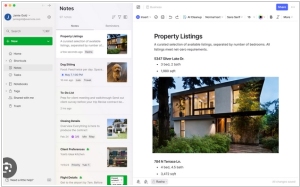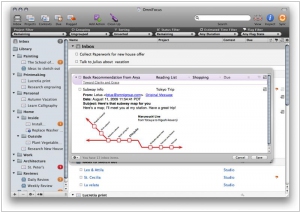Evernote vs Omnifocus
March 08, 2025 | Author: Adam Levine
21★
A suite of software and services designed for notetaking and archiving. Allows organizing notes with notebooks, tags, and customizable templates. Offers built-in task management with reminders and to-do lists.
14★
OmniFocus is designed to quickly capture your thoughts and ideas to store, manage, and help you process them into actionable to-do items. Perfect for many different systems, OmniFocus helps you work smarter by giving you powerful tools to stay on top of all the things you need to do. From ‘Call mom’ to ‘Submit Annual Report to Investors’.
Evernote and OmniFocus are both, in their own peculiar ways, dedicated to the grand human struggle of organizing an appalling mess of thoughts, tasks and half-baked ideas. They both promise synchronization across devices, which means you can seamlessly forget your to-do list anywhere in the universe. Tags and search functions ensure you can lose things in a more structured way, while integrations with various other apps provide an illusion of productivity. Most crucially, both have found a comfortable home on Apple devices, presumably because their users enjoy feeling superior while getting nothing done.
Evernote, born in 2008 in the grand tradition of American software companies, was designed to be the ultimate memory extension for people who had long since given up remembering things themselves. It lets you store notes, scan documents and generally hoard digital detritus like a squirrel preparing for an extremely well-documented winter. It even has OCR, which means you can search for words in blurry photographs of receipts you’ll never need again. And because every utopian vision needs a capitalist twist, it operates on a freemium model, enticing users with just enough storage to realize they need to pay for more.
Meanwhile, OmniFocus, also hatched in 2008 but with a more disciplined air, takes an entirely different approach. Created by The Omni Group—who presumably named themselves after their omniscient ability to organize things—it follows the Getting Things Done (GTD) methodology with military precision. Instead of letting you casually stash ideas, it demands you categorize, prioritize and generally act like a responsible adult. It doesn’t bother with document scanning or other such frivolities because if a task isn’t meticulously planned, it simply doesn’t exist. Unlike Evernote, it offers a one-time purchase option, though this is balanced out by its Pro version, which comes with automation tools for people who enjoy automating the process of not doing things.
See also: Top 10 Productivity software
Evernote, born in 2008 in the grand tradition of American software companies, was designed to be the ultimate memory extension for people who had long since given up remembering things themselves. It lets you store notes, scan documents and generally hoard digital detritus like a squirrel preparing for an extremely well-documented winter. It even has OCR, which means you can search for words in blurry photographs of receipts you’ll never need again. And because every utopian vision needs a capitalist twist, it operates on a freemium model, enticing users with just enough storage to realize they need to pay for more.
Meanwhile, OmniFocus, also hatched in 2008 but with a more disciplined air, takes an entirely different approach. Created by The Omni Group—who presumably named themselves after their omniscient ability to organize things—it follows the Getting Things Done (GTD) methodology with military precision. Instead of letting you casually stash ideas, it demands you categorize, prioritize and generally act like a responsible adult. It doesn’t bother with document scanning or other such frivolities because if a task isn’t meticulously planned, it simply doesn’t exist. Unlike Evernote, it offers a one-time purchase option, though this is balanced out by its Pro version, which comes with automation tools for people who enjoy automating the process of not doing things.
See also: Top 10 Productivity software




